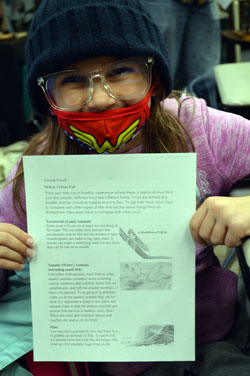Northview — Two years ago when some of the district’s field school students got to step into the Rogue River and try fly fishing for the first time, they used ties supplied by members of Trout Unlimited, the professional organization that led the lesson.
The next time the third- and fourth-graders cast their lines, they could be using flies they tied themselves.
Rich Youngberg, the district’s coordinator of outdoor experiences, led students recently in a quick introduction to entomology, or, more specifically, aquatic macroinvertebrates, a word third-grader Hayden Borek knew: “Bugs,” he said. “Insects.”

Then, in answer to Youngberg’s question “what do all macroinvertebrates have in common?” Hayden guessed: “They have wings?”
Clarified Youngberg: “Good guess, but not quite. They’re bugs without a backbone.”
Before students created their own flies, Youngberg told them it was important that these replicas look like the real thing. Macroinvertebrate flies are used often by fly-fishing aficionados because their presence indicates the health of rivers and streams — and thus a plentiful fish population.
In groups of five, students sat in front of a vise used to hold in place the hook they would build their fly onto, using thread to wrap and pinch marabou turkey feathers, saddle hackle rooster feathers and chenille flashing used to simulate the wiggly bugs.
Hayden, who said he has already caught “about 2,000 trout,” said he might use his when he goes deep-sea fishing. Third-grader Zia Duffing regarded her creation and said she would probably hang it above the bottom bunk bed at home where she sleeps.

Youngberg, who leads a fly-fishing club at the high school, said this was the first time he led a fly-tying lesson with students this young.
“I learned a lot about my teaching skills and how to adapt, doing it with younger students,” he said.
And not only were they honing soft skills such as patience, listening, following directions and how important it is to practice, “what’s great is they’re using their fine motor skills,” he said. “I’m happy with the end results, for sure, but it’s not about the end result; it’s their enthusiasm, and that they want to do it more.”
The fly tying will be picked up again in the spring, when students do a deeper dive into the study of entomology and macroinvertebrates. Youngberg said he hopes they will be able to visit a river or stream to try out their casting skills, explore water health and incorporate art by drawing what they come across.
“The kids always love that,” he said. “They are just enthralled with all things bugs.”












